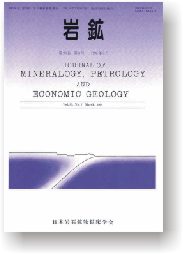巻号一覧

91 巻, 5 号
May
選択された号の論文の4件中1~4を表示しています
- |<
- <
- 1
- >
- >|
総説
-
—— 三波川変成岩と大文字接触変成岩への適用とその評価 ——中村 大輔1996 年 91 巻 5 号 p. 165-176
発行日: 1996年
公開日: 2006/11/25
ジャーナル フリーGarnet-biotite geothermometer has been used commonly in determining temperatures of metamorphism. Application of some garnet-biotite thermometers to the Sanbagawa and the Daimonji metamorphic rocks reveals that those of Hodges and Spear (1982) and Dasgupta et al. (1991) are the most compatible with other geothermometers and paragenetic relations. Though these thermometers are based on the solid solution model assuming symmetrical mixing, the results from them are consistent with those of Berman's (1990) asymmetrical mixing model for garnet. Therefore, for garnet with XCa < 0.30 and XMn < 0.40 from those areas, the symmetrical model produces not so much different estimated temperatures from the asymmetrical model. Difficulties in evaluation of the effects of Mn in garnet and Ti and Al in biotite on the thermometers remain even now, but these two give reasonable temperatures.抄録全体を表示PDF形式でダウンロード (1713K)
論説
-
1. 噴出様式の時間変化高橋 正樹, 吉田 英人1996 年 91 巻 5 号 p. 177-184
発行日: 1996年
公開日: 2006/11/25
ジャーナル フリーThe Shirakawa pyroclastic flows consist of four pyroclastic flow deposits erupted about 1.3-1.0 Ma in the southern part of Tohoku-Honshu arc. These eruptions are characterized by two different modes of eruption. The eruptions of the older two deposits, the Kumado and Ashino pyroclastic flows, were followed by many numbers of intermittent Plinian eruptions, which persisted for about a few ten thousand years. It is thought that the mode of volcanic eruption corresponds to that of a polygenetic volcano. In contrast, the eruptions of the younger two deposits, the Nishigo and Ten-ei pyroclastic flows, were both single eruption event and no subsequent Plinian eruption was associated. The mode of eruption is similar to that of a monogenetic volcano. The duration of repose between each eruption of pyroclastic flow deposits exceeded a few ten thousand years and is nearly comparable with that of the Aso volcano and longer than that of the Towada volcano (10 or 20 thousand years). The estimated whole life span of the volcanic activity of the Shirakawa pyroclastic flows is about 250 thousand years. It seems to be rather shorter than that of a ordinary Quaternary stratovolcano.抄録全体を表示PDF形式でダウンロード (1197K) -
Abdel-Aal M. ABDEL-KARIM1996 年 91 巻 5 号 p. 185-195
発行日: 1996年
公開日: 2006/11/25
ジャーナル フリーThe paper represents the field, petrographic and geochemical characteristics of late Precambrian granites of Wadi Baba-Wadi Seih area in southwestern Sinai. They are composed of biotite granites and leucogranites. The biotite granites are fluorite non-bearing, vary from monzo- to syenogranites, which cut by felsic dykes, and probably correspond to the phase II of Egyptian Younger Granites. The leucogranites are fluorite bearing, range from syenogranites to alkali feldspar granites, cut the phase II and felsic dykes and belong to the phase III granites.
Petrographic and geochemical data reveal a peraluminous type and potassic-sodic character of the present younger granites. They were originated at 20->30 km depth as shallow- to moderate-level intrusives. They were mostly originated in intraplate environment with extensional regime.
In general, the biotite granites have alkaline character, probably exhibit the features of S-type granite, and are derived by partial melting of the lower crustal materials. On the other hands, the leucogranites have strong alkaline and peralkaline charcters, largely similar to the A-type granite with high silica, alkalis and normative acmite, and were formed through partial melting of lower crustal materials followed by crystal fractionation of a fluorine-rich I-type magma.抄録全体を表示PDF形式でダウンロード (1428K)
短報
-
鹿島 愛彦, 武智 賢樹1996 年 91 巻 5 号 p. 196-200
発行日: 1996年
公開日: 2006/11/25
ジャーナル フリーThe Kuma Group, Shikoku, has been referred as Eocene deposits since Nagai (1956). Here we report new fission-track ages from the Kariba Sandstone-Mudstone Formation. Our data indicate that the group is of Early Miocene age.抄録全体を表示PDF形式でダウンロード (653K)
- |<
- <
- 1
- >
- >|